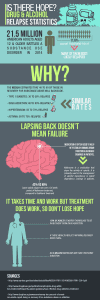According to the National Survey on Drug Use and Health(NSDUH), 21.5 million American adults (aged 12 and older) battled a substance use disorder in 2014 and only 11.6 percent sought treatment for it. Of those who sought alcohol substance abuse treatment, unfortunately, many of them likely relapsed. How can this be?  The chronic nature of this disease means that relapsing to drug abuse is likely. Treatment research from the National Institute on Drug Abuse estimates that 40 to 60 of those in recovery for substance abuse will backslide. At first glance, this may seem like a hopeless statistic. However, addiction relapse rates are similar to relapse rates for other well-researched chronic illnesses, such as diabetes, hypertension, and asthma. Those patients also fail to make the proper lifestyle choices or stop taking their medication.
The chronic nature of this disease means that relapsing to drug abuse is likely. Treatment research from the National Institute on Drug Abuse estimates that 40 to 60 of those in recovery for substance abuse will backslide. At first glance, this may seem like a hopeless statistic. However, addiction relapse rates are similar to relapse rates for other well-researched chronic illnesses, such as diabetes, hypertension, and asthma. Those patients also fail to make the proper lifestyle choices or stop taking their medication.  With this frame of mind, you can see how likely relapse is for many diseases:
With this frame of mind, you can see how likely relapse is for many diseases:
- Type 1 diabetes – 30 to 50% relapse
- Drug Addiction – 40 to 60% relapse
- Hypertension – 50 to 70% relapse
- Asthma – 50 to 70% relapse
The numbers for drug addiction are typical for those battling chronic illnesses, and therefore relapse should not be felt like a failure. Lapsing back to drug use does not mean that a person should give up. Just like it’s approached for those who relapse from other chronic illnesses, those seeking addiction recovery should not be thought of as “incurable.” Instead, it suggests change needs to occur, whether treatment needs to be reinstated or adjusted, or that another treatment should be tried.  There are many factors that can help lower the rate of relapse and send more patients on the road to recovery. Medication is often used to help re-establish normal brain function and decrease cravings in patients. Medications are available for the treatment of opioids (heroin, prescription pain relievers), tobacco (nicotine), and alcohol addictions. A recent 2016 study funded by the National Institute on Drug Abuse (NIDA) was able to prove the effectiveness of extended-release naltrexone on the relapse rates for opioid-dependent adults in the criminal justice system. The findings showed that 24 weeks of the medication resulted in a significantly lower opioid relapse rate (43 percent vs. 64 percent). Those who received the medication were compared against those who received treatment as usual (brief counseling and referrals for community treatment programs). In addition, there were no overdoses in the extended-release naltrexone group, yet there were seven in the usual care group. More research needs to be done on the influence of medication on relapse rates, but this is a good sign that things can be done to lower the risk.
There are many factors that can help lower the rate of relapse and send more patients on the road to recovery. Medication is often used to help re-establish normal brain function and decrease cravings in patients. Medications are available for the treatment of opioids (heroin, prescription pain relievers), tobacco (nicotine), and alcohol addictions. A recent 2016 study funded by the National Institute on Drug Abuse (NIDA) was able to prove the effectiveness of extended-release naltrexone on the relapse rates for opioid-dependent adults in the criminal justice system. The findings showed that 24 weeks of the medication resulted in a significantly lower opioid relapse rate (43 percent vs. 64 percent). Those who received the medication were compared against those who received treatment as usual (brief counseling and referrals for community treatment programs). In addition, there were no overdoses in the extended-release naltrexone group, yet there were seven in the usual care group. More research needs to be done on the influence of medication on relapse rates, but this is a good sign that things can be done to lower the risk.  Other research suggests that nationally, addiction recovery is becoming more successful. A 2012 study released by the Partnership at Drugfree.org and the New York State Office of Alcoholism and Substance Abuse Services (OASAS) indicated that 10 percent of adults consider themselves to be in recovery from drug addiction. If these results reflect national recovery rates, 23.5 million Americans may have overcome the disease of drug addiction.
Other research suggests that nationally, addiction recovery is becoming more successful. A 2012 study released by the Partnership at Drugfree.org and the New York State Office of Alcoholism and Substance Abuse Services (OASAS) indicated that 10 percent of adults consider themselves to be in recovery from drug addiction. If these results reflect national recovery rates, 23.5 million Americans may have overcome the disease of drug addiction.  While on the road to addiction recovery, it’s important not to get disappointed and lost in statistics. You are an individual, who deserves the best shot at recovery. For a majority of patients, treatment does work, even if it takes time.
While on the road to addiction recovery, it’s important not to get disappointed and lost in statistics. You are an individual, who deserves the best shot at recovery. For a majority of patients, treatment does work, even if it takes time.

